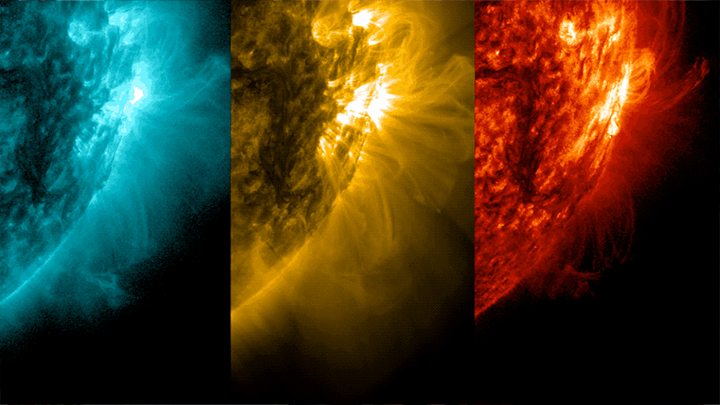Q&A: As the Sun nears its 11-year solar maximum, what can we expect here on earth?
Associate Professor of Astronomy Douglas Leonard explains why sunspots, solar flares, and space weather events increase in frequency as the Sun's magnetic field flips.

Every 11 years the Sun’s magnetic pole flips. Leading up to this event, there is a period of increased solar activity — from sunspots and solar flares to spectacular northern and southern lights. The current solar cycle began in 2019 and scientists predict it will peak sometime in 2024 or 2025 before the Sun returns to a lower level of activity in the early 2030s.
SDSU NewsCenter’s Susanne Clara Bard asked associate professor of astronomy Douglas Leonard to explain the science behind the solar maximum, and whether the phenomenon poses any threats to us here on earth.
Scientists have dubbed this “solar cycle 25”. How did scientists determine that the solar cycle is 11 years long?
Although some speculation had occurred during the 18th century, the first decisive identification of an 11-year solar cycle comes from 1843, when the German amateur astronomer Heinrich Schwabe identified it through a careful analysis of the number of sunspots visible on the Sun's surface over time. What he found was that this number reaches a minimum value (typically zero!) roughly every 11 years. Evidence suggests that this 11-year cycle has been relatively stable for at least hundreds of millions of years. It also appears that our Sun is not unique — other stars appear to have similar cycles, although their durations vary considerably.
Since Schwabe's time, astronomers have continued to directly observe this 11-year cycle of sunspot activity. What's more, from tree-ring dating techniques involving the quantity of the radioactive isotope carbon-14 present, we can accurately infer the solar cycle back about 14,000 years. And, as best we can tell, fossil records indicate that this solar cycle has been relatively stable for at least hundreds of millions of years.
What does it mean when the Sun’s magnetic field flips and how does this affect sunspots and other phenomena?
To be honest, the Sun's magnetic field is an extremely complex phenomenon, and no one would claim that we completely understand it. But, in a nutshell, we know that it starts with the Sun being a big, hot ball of mostly hydrogen gas, in which the atoms are essentially completely ionized, which means that the electrons are all ripped away from the protons. Having such charged particles zipping and churning around ultimately generates a magnetic field. What we know about this magnetic field is that its "polarity" — its "North" and "South" magnetic poles — swap places on this same 11-year solar cycle. And right as the polarity is about to flip, we witness a strong increase in solar activity: increases in sunspots, flares (eruptions on the Sun's surface), and even coronal mass ejections (huge releases of solar plasma thrown out into space). Once this happens, we slowly enter a period in which not much solar activity occurs — the solar minimum.
How does the solar cycle affect space weather and auroras?
The most dramatic events produced by the solar photosphere (the "surface" of the Sun) are coronal mass ejections. When these occur and solar particles get spewed out into space, they can wash over the Earth and interact with our magnetic field. This interaction funnels the charged particles towards Earth's own North and South magnetic poles — where the particles interact with molecules in Earth's ionosphere and cause them to fluoresce — phenomena known as aurora borealis (northern lights) and aurora australis (southern lights).
When can we expect the solar maximum to occur? Is it approaching sooner than normal during this cycle?
This is a tricky question! In 2019, it was predicted that the solar maximum would likely occur sometime around July 2025. However, Nature does not have to conform with our predictions, and seems to be giving us the maximum earlier than expected. In fact, there's some thought that we may already be experiencing it right now. We won't know for sure, though, until we are about half a year beyond the peak and have enough post-peak data to indicate that it really was the peak.
Some people believe that the solar maximum could cause mass outages and could be extremely disruptive to society, given how reliant we are on modern electronics, power grids, and global communications. Is this a plausible scenario?
Yes, I'm sorry to report that it is certainly plausible, but fortunately, unlikely. Very strong solar activity — especially the coronal mass ejections — can indeed wreak some havoc on our satellite and communication electronics. Most often, it is fairly minor — we get what is known as a "radio blackout" that interferes with some of our radio communications. Once in a while, though, a major solar event occurs. The last of these was in 1859 in what is now known as the Carrington Event, which knocked out telegraph communications across Europe and North America. Should a similar solar storm happen today it would be fairly devastating, affecting major aspects of our infrastructure including our power grid and, (gasp), the internet itself. Although predicting such events is fraught with uncertainties, most experts place the chance at about 1% during this cycle. We live with the Sun, and the Sun will do what it is going to do!
Design by Mario Sevilla


